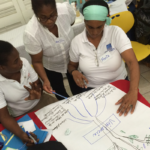Intimate partner violence (IPV) is a global and complex problem with no single solution. Increasingly programs addressing IPV in low- and middle-income countries (LMICs) incorporate social norms approaches. A well-known example is SASA! implemented by Raising Voices in Uganda; another example is theater of the oppressed produced by Jana Sanskriti in India. By coincidence, while I was writing up a rapid systematic review of the evidence for norms-based approaches to behavior change, I was asked by the Centre of Excellence for Development Impact and Learning (CEDIL) to chair a webinar featuring a new study of the Jana Sanskriti program. For the review, although I searched for studies across sectors and topics, it turned out a large share of the included studies evaluate programs addressing IPV or gender-based violence (GBV). In this post, I present some findings from the IPV and GBV subset of studies from the review. I find that the evidence is mixed – some programs do demonstrate an effect on behavioral outcomes, but many do not. The programs evaluated are highly heterogeneous, so unfortunately, generalizable conclusions are elusive.
Methods
The rapid systematic review (or rapid evidence review) is my second pilot review in an initiative, described here, to refine rapid review approaches to meet the needs of decision makers for unbiased evidence review in a short period of time. For this review, the question agreed with my colleagues was “What is the recent evidence about the effectiveness of behavior change interventions that incorporate social norms approaches in improving behavioral outcomes in support of improving lives in LMICs?” Although some of our immediate evidence needs focused on health behavior change, we wanted to learn about social norms approaches across sectors. We knew that there are many studies that measure norms outcomes (as well as knowledge and attitudes), but we decided from the beginning to limit the review to studies that measure actual behavior change outcomes, so that we’d have the best evidence for behavior change programming. The review includes impact evaluations, i.e., quantitative studies that measure net effects using contemporaneous program and comparison groups, and systematic reviews that have impact evaluations among their included studies.
The hardest of the inclusion criteria to apply was that the intervention used a norms-based approach. For an individual, social norms are what other people in a relevant social grouping do and think. Some social norms approaches seek to change individuals’ perceptions of the prevailing social norms, while others seek to change the prevailing social norms. In the latter case, the relationship between attitudes, behaviors and norms is circular – if enough people change their individual attitudes and behaviors, then what any individual sees as the social norm will change, which can in turn motivate her or his own attitudes and behaviors. The search strings for the review required the term “norms” or “social norms” in title, abstract or keywords, but that did not guarantee that the study evaluated a norms-based intervention. For the purpose of screening studies into the review, I looked at the descriptions of the interventions to judge whether they included messages or activities focused on social norms and not just attitudes and knowledge.
The search returned just over 1,300 hits after deduplication, and the screening process identified dozens of studies meeting the prespecified inclusion criteria (the protocol for the review is registered here). To produce a report within the promised timeframe that addressed the most pressing evidence needs*, I coded the included studies for whether the norms employed by the interventions are direct norms or are what Heise and Manji (2016) call meta norms, which are norms that influence several behaviors. For direct norms, you can think of college students’ perceptions of their peers’ binge drinking behavior as influencing their own binge drinking decisions. For meta norms, you can think of social views about healthy sexuality influencing decisions about risky sexual behavior and communication with sexual partners. In the first manuscript (submitted version available here) I focus on the evidence for meta norms-based programming, which encompasses seven systematic reviews and 28 primary studies.
IPV and GBV norms-based programming evidence base
Among the systematic reviews and primary studies reviewed in that manuscript are two systematic reviews and ten primary studies (evaluating nine programs) of IPV or GBV interventions. Table 1 lists systematic reviews and their features and table 2 (at the end of this post) lists the primary studies and their features.
| Study | Title | Geography | Interventions | Participants | Behavioral outcomes | Number of included studies |
|---|---|---|---|---|---|---|
| Bourey et al., 2015 | Systematic review of structural interventions for intimate partner violence in low- and middle-income countries: Organizing evidence for prevention | LMICs | Structural interventions to prevent male-perpetrated IPV including economic, social, and combined economic and social interventions | Adults | IPV incidence (or prevalence) | 20 articles covering 16 programs |
| Nikolova and Small, 2018 | Review of the evidence of gender-focused interventions including men to reduce HIV risk and violence against women in sub-Saharan Africa | Sub-Saharan Africa | HIV and HIV risk programs including or focused on men that also address violence against women | Adults | HIV risk | 17 articles covering 13 programs |
As shown in table 2, all of the primary studies were conducted in Africa except one in India and one in Mexico. Not shown in the table, six of the ten (including two for one program) used random assignment or cluster random assignment as the identification strategy, and the other four used double difference. These studies suggest the following conclusions about the evidence for social norms-based approaches to reducing IPV and GBV in LMICs.
The evidence base for norms-based programs is small
The Bourey et al. (2015) review searched for all studies of IPV programs in LMICs using structural interventions. They only found programs in two of their proposed categories – economic and social – but even among those they classify as social or combining social and economic, not all are social norms-based. They conclude that the reviewed evidence suggests the “potential” for structural interventions to reduce IPV, but they do not recommend specific interventions. They recommend additional research. My search only went back to articles published in 2010 but covered five more recent years than Bourey et al. and still only found ten primary studies (covering nine programs) meeting the inclusion criteria.
Much of the evidence comes from programs that combine HIV prevention and IPV reduction
Four of the nine programs evaluated by the primary studies are programs that combine both HIV prevention and IPV reduction messages and activities. For example, the Unite for a Better Life program in Ethiopia evaluated by Sharma et al. (2020) was designed to use coffee ceremonies to build the skills of men, women, and couples to prevent HIV transmission and IPV perpetration. The prevalence of these combined programs is notable enough that the Nikolova and Small (2018) review focuses exclusively on interventions “used to address the synergy between VAW [violence against women] and HIV risk in sub-Saharan African countries” (p. 89). Not all the interventions covered in their review use social norms approaches, though. They conclude that “most interventions showed positive effects” (p. 87) but this is across many measured outcomes. Nikolova and Small do not recommend any particular programs or approaches.
The intervention activities are highly heterogeneous
The duration of the nine interventions evaluated by the primary studies ranges from one month (or less) to 48 months. Some programs emphasize activities at the community level, for example the Male Norms Initiative in Ethiopia, evaluated by Pulerwitz et al. (2015), that used community mobilization and engagement. However, most include some activities at the individual level, but these activities vary widely, including group discussions, participatory training, microfinance loans, classroom-based workshops, and peer-led role playing and action planning. Many programs include activities at both the community and individual levels.
The effectiveness of these programs for reducing the perpetration of violence is mixed
Several studies were not able to measure detectable effects of the interventions on behavioral outcomes. For example, Christofides et al. (2020) reports, “We found that the intervention did not significantly affect any of the primary or secondary outcomes. There was no effect on men’s past year use of physical or sexual IPV or a reduction in severe IPV” (p. 10). Some studies have suggestive but not strong findings. For example, Miller et al. (2014) explains, “Fewer negative intervention behaviors (i.e., laughing and going along with peers’ abusive behaviors) were reported by intervention athletes at follow-up compared with comparison athletes, but this difference was only marginally significant” (p. 771). Only two of the studies measured statistically significant changes in IPV perpetration. The Sharma et al. (2020) evaluation of Unite for a Better Life in Ethiopia finds the men’s intervention “significantly reduced male perpetration of past-year sexual IPV” but “no intervention reduced past-year physical IPV” (p. 2). And Sosa-Rubi et al. (2017) report a 58% reduction in the prevalence of perpetrated psychological violence among male adolescents who were exposed to the combined school climate and individual-level components of True Love in Mexico as opposed to those who were only exposed to the school climate component.
Many of these programs are effective at changing other behaviors
While all studies needed to measure a behavioral outcome to be included in the main review, not all of these studies measure an IPV or GBV behavioral outcome. For example, the Kyegombe et al. (2014) and Watts et al. (2015) studies of the SASA! intervention measure behavioral outcomes for HIV prevention but not behavioral outcomes for IPV. Watts et al. report, for example, that SASA! had significant impact on reducing sexual concurrency among men. The Doyle et al. (2018) evaluation of the Bandebereho program in Rwanda measures behavioral outcomes related to male engagement in reproductive health care finding, for example, that the program improved partner support during pregnancy.
Discussion
Applying the existing evidence to new programming is complicated by the heterogeneity of the programs evaluated. Rather than look for generalizable recommendations, program designers may find more useful answers by looking at the evidence for programs and contexts best matched to theirs. I would also caution designers about applying evidence from combined HIV and IPV programs to programs just focusing on IPV. As suggested by Nikolova and Small, there are likely synergies between the two.
I’ll conclude this post with a clarification that came up in a conversation with a colleague about these results. To say that the current evidence is weak for using social norms-approaches to reduce IPV does not mean that social norms are not an important piece of the IPV puzzle. They most certainly are. It just means that we don’t have much evidence yet for how to design programs to shift meta norms to detectably change behavior over a set period of time.
| Study | Title | Country program | Intervention activities | Norms | Duration months | Participants/ sex |
|---|---|---|---|---|---|---|
| Christofi-des et al., 2020 | Effectiveness of a multi-level intervention to reduce men's perpetration of intimate partner violence: A cluster randomised controlled trial | South Africa: Sonke Community Health Action for Norms and Gender Equality (CHANGE) | Door-to-door discussions, community action teams, workshops | Gender power, gender-based violence, sexuality | 18 | Adults/ Male |
| Doyle et al., 2018 | Gender-transformative Bandebereho couples' intervention to promote male engagement in reproductive and maternal health and violence prevention in Rwanda: Findings from a randomized controlled trial | Rwanda: Bandebe-reho | Small group sessions with curriculum for couples and men and women separately | Gender equality, fatherhood, maternal health, intimate partner violence | 5 | Adults/ Both |
| Kyegom-be et al., 2014 | The impact of SASA!, a community mobilization intervention, on reported HIV-related risk behaviours and relationship dynamics in Kampala, Uganda | Uganda: SASA! | Community activists, training of professionals, door-to-door visits, community dramas and films, community conversations | Gender equality and power, gender-based violence | 48 | Adults/ Both |
| Maman et al., 2020 | Results from a cluster-randomized trial to evaluate a microfinance and peer health leadership intervention to prevent HIV and intimate partner violence among social networks of Tanzanian Men | Tanzania: Microfinance and peer health program for social networks of men | Business and entrepreneurship training, microfinance loans, investment groups, peer health leader training, peer health discussions | Gender-based violence and power, safe sex | 30 | Adults/ Male |
| Miller et al., 2014 | Evaluation of a gender-based violence prevention program for student athletes in Mumbai, India | India: Parivartan (Coaching Boys Into Men) | Training of coaches, coach role models, coach-led discussions with players | Gender equity, gender-based violence, abuse | 4 | Adolescents/ Male |
| Pulerwitz et al., 2015 | Changing gender norms and reducing intimate partner violence: Results from a quasi-experimental intervention study with young men in Ethiopia | Ethiopia: Male Norms Initiative | Interactive group education, community mobilization and engagement, Engaging Boys and Men in Gender Transformation manual | Gender equality, sexual health, intimate partner violence | 1 | Youth/ Male |
| Sharma et al., 2020 | Effectiveness of a culturally appropriate intervention to prevent intimate partner violence and HIV transmission among men, women and couples in rural Ethiopia: Findings from a cluster-randomized controlled trial | Ethiopia: Unite for a Better Life (UBL) | Participatory and skills building sessions delivered as part of coffee ceremonies | Gender equality and power, sexuality, violence | 2 | Adults/ Both |
| Sosa-Rubi et al., 2017 | True Love: Effectiveness of a school-based program to reduce dating violence among adolescents in Mexico City | Mexico: True Love | Training of school staff, schoolyard activities, classroom-based workshops, community engagement | Gender equality, dating violence, sexual rights | 4 | Adolescents/ Both |
| Wagman et al., 2015 | Effectiveness of an integrated intimate partner violence and HIV prevention intervention in Rakai, Uganda: Analysis of an intervention in an existing cluster randomised cohort | Uganda: Safe Homes and Respect for Everyone Project (SHARE) | Community-based mobilization through advocacy, training, learning materials, and special events plus one-on-one intervention with women seeking HCT | Gender rights, intimate partner violence | 4 | Adults/ Both |
| Watts et al., 2015 | The SASA! study: A cluster randomised trial to assess the impact of a violence and HIV prevention programme in Kampala, Uganda | Uganda: SASA! | Community activists, training of professionals, door-to-door visits, community dramas and films, community conversations | Gender equality and power, gender-based violence | 32 | Adults/ Together |
| Wechs-berg et al., 2016 | The male factor: Outcomes from a cluster randomized field experiment with a couples-based HIV prevention intervention in a South African township | South Africa: Couples Health Coop, Women's/ Men's Health Coop | Peer-led workshops with groups in community libraries including role playing and action planning | Gender equality, sexuality, intimate partner violence, communication | 1 | Adults/ Both |
*The protocol stated the rapid review would be completed in six weeks. In the end, due to staffing changes, it took ten weeks from initiating the searches to submitting the first draft of the manuscript to my colleagues and another two weeks to submit it to a journal.
Photo credit: MangoStar_Studio/Getty



